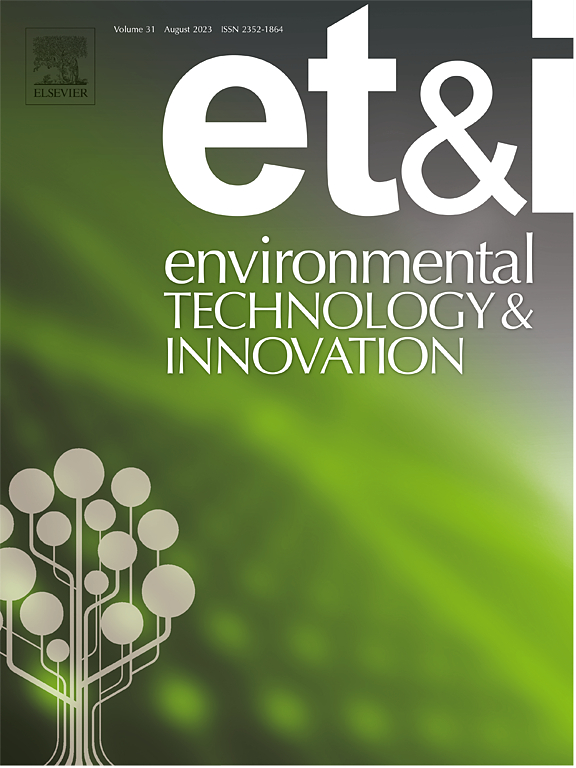Phosphoric acid modified biochar enhanced heavy metals passivation via accelerating humification and bioremediation in sewage sludge composting
IF 6.7
2区 环境科学与生态学
Q1 BIOTECHNOLOGY & APPLIED MICROBIOLOGY
引用次数: 0
Abstract
This study investigated the effects of phosphoric acid modified coconut shell biochar (PMB) on humification parameters, heavy metals bioavailability, and the structure and metabolism of bacterial community during sewage sludge composting. The results indicated that PMB addition decreased the polyphenols content and increased polyphenol oxidase (PPO) and laccase activity. At the end of composting, the humic acid (HA) concentration of PMB treatment rose by 22.19 %, and the degree of polymerization and humification index (HIX) also increased significantly, compared with control (CK) treatment. In addition, the bioavailable contents of Cu, Fe, Mn, Ni, Pb and Zn in PMB were significantly lower than CK, which decreased by 19.32 %, 35.28 %, 39.72 %, 41.99 %, 36.28 % and 32.27 %, respectively. The addition of PMB enhanced the richness and diversity of bacterial community. The abundances of sequences associated with carbohydrate metabolism, amino acid metabolism, energy metabolism and lipid metabolism in PMB were consistently higher than that in CK. Correlation analysis showed that Streptomyces, Bacillus, Pseudomonas and Taibaiella were significantly positively associated with heavy metals passivation and HA formation. These findings suggested that PMB promoted organic matter decomposition and HA formation, and decreased bioavailability of heavy metals by promoting bacterial bioremediation and HA absorption and complexation. Therefore, the addition of PMB is a suitable strategy to mitigate the environmental risk of heavy metals in sewage sludge.
磷酸改性生物炭通过加速污泥腐殖质化和生物修复来增强污泥堆肥中重金属的钝化
研究了磷酸改性椰壳生物炭(PMB)对污泥堆肥过程中腐殖化参数、重金属生物有效性以及细菌群落结构和代谢的影响。结果表明,添加PMB可降低多酚含量,提高多酚氧化酶和漆酶活性。堆肥结束时,PMB处理腐植酸(HA)浓度较对照(CK)提高22.19 %,聚合度和腐殖化指数(HIX)也显著提高。此外,PMB处理的Cu、Fe、Mn、Ni、Pb和Zn的生物利用度含量显著低于对照处理,分别降低了19.32 %、35.28 %、39.72 %、41.99 %、36.28 %和32.27 %。PMB的添加提高了细菌群落的丰富度和多样性。PMB中碳水化合物代谢、氨基酸代谢、能量代谢和脂质代谢相关序列的丰度均高于对照。相关分析表明,链霉菌、芽孢杆菌、假单胞菌和太白菌与重金属钝化和HA形成呈显著正相关。这些结果表明,PMB通过促进细菌的生物修复和HA的吸收和络合作用,促进有机物分解和HA的形成,降低重金属的生物利用度。因此,添加PMB是减轻污泥中重金属环境风险的一种合适的策略。
本文章由计算机程序翻译,如有差异,请以英文原文为准。
求助全文
约1分钟内获得全文
求助全文
来源期刊

Environmental Technology & Innovation
Environmental Science-General Environmental Science
CiteScore
14.00
自引率
4.20%
发文量
435
审稿时长
74 days
期刊介绍:
Environmental Technology & Innovation adopts a challenge-oriented approach to solutions by integrating natural sciences to promote a sustainable future. The journal aims to foster the creation and development of innovative products, technologies, and ideas that enhance the environment, with impacts across soil, air, water, and food in rural and urban areas.
As a platform for disseminating scientific evidence for environmental protection and sustainable development, the journal emphasizes fundamental science, methodologies, tools, techniques, and policy considerations. It emphasizes the importance of science and technology in environmental benefits, including smarter, cleaner technologies for environmental protection, more efficient resource processing methods, and the evidence supporting their effectiveness.
 求助内容:
求助内容: 应助结果提醒方式:
应助结果提醒方式:


